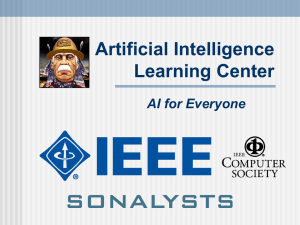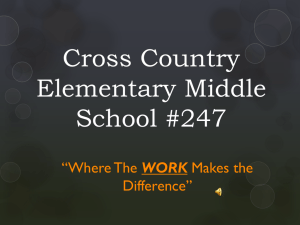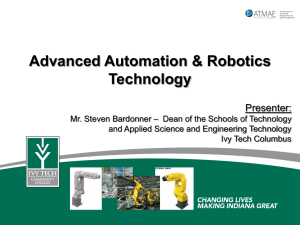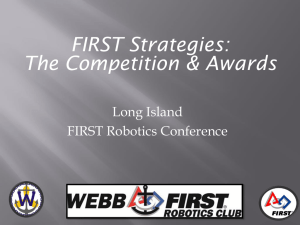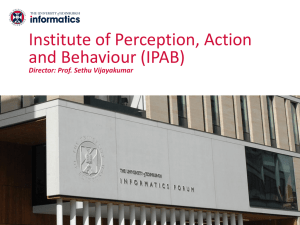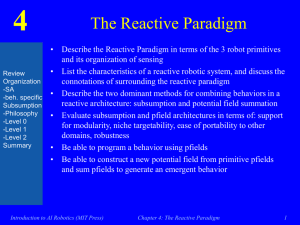Probabilistic Robotics - Course overview
advertisement
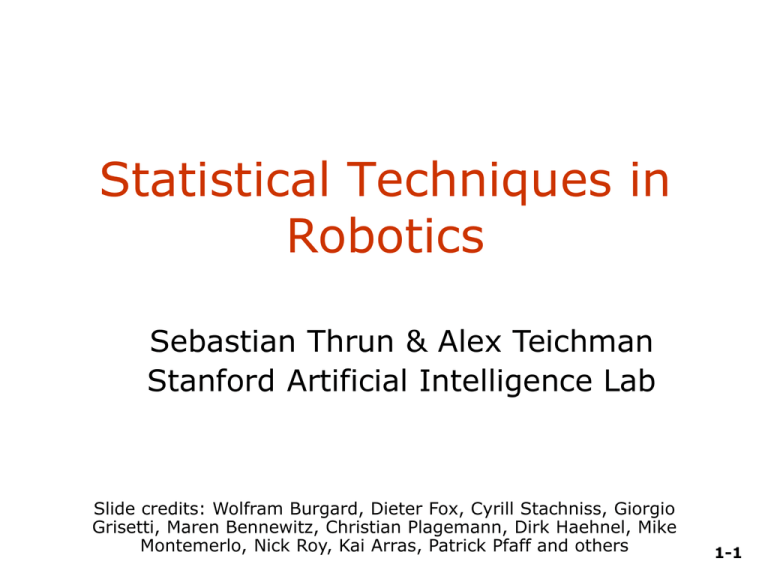
Statistical Techniques in Robotics Sebastian Thrun & Alex Teichman Stanford Artificial Intelligence Lab Slide credits: Wolfram Burgard, Dieter Fox, Cyrill Stachniss, Giorgio Grisetti, Maren Bennewitz, Christian Plagemann, Dirk Haehnel, Mike Montemerlo, Nick Roy, Kai Arras, Patrick Pfaff and others 1-1 Course Staff • Lectures: Sebastian Thrun • thrun@stanford.edu • CA: Alex Teichman, PhD Candidate • teichman@stanford.edu 1-2 Time and Location • 200-203 (???) • M/W 9:30-10:45 • Web: cs226.stanford.edu 1-3 Requirements • Warm-up assignments • written assignments (about 3) • research project (in teams), 30% • midterm, 30% 1-4 Text Book: Probabilistic Robotics 1-5 Goal of this course • Introduction to Contemporary Robotics • Provide an overview of problems / approaches in probabilistic robotics • Probabilistic reasoning: Dealing with noisy data • Some hands-on experience and exercises 1-6 AI View on Mobile Robotics Sensor data Control system World model Actions 1-7 Robotics Yesterday 1-8 Current Trends in Robotics Robots are moving away from factory floors to • • • • Entertainment, toys Personal services Medical, surgery Industrial automation (mining, harvesting, …) • Hazardous environments (space, underwater) 1-9 Robotics Today 1-10 RoboCup-99, Stockholm, Sweden 1-11 Mobile Manipulation [Brock et al., Robotics Lab, Stanford University, 2002] 1-12 Mobile Manipulation 1-13 Humanoids: P2 Honda P2 ‘97 1-14 Emotional Robots: Cog & Kismet [Brooks et al., MIT AI Lab, 1993-today] 1-15 Brief Case Study: Museum Tour-Guide Robots Rhino, 1997 Minerva, 1998 1-16 Rhino (Univ. Bonn + CMU, 1997) 1-17 Minerva (CMU + Univ. Bonn, 1998) Minerva 1-18 Robot Paradigms 1-19 Robotics: General Background • Autonomous, automaton • self-willed (Greek, auto+matos) • Robot • Karel Capek in 1923 play R.U.R. (Rossum’s Universal Robots) • labor (Czech or Polish, robota) • workman (Czech or Polish, robotnik) 1-20 Asimov’s Three Laws of Robotics 1. A robot may not injure a human being, or, through inaction, allow a human being to come to harm. 2. A robot must obey the orders given it by human beings except when such orders would conflict with the first law. 3. A robot must protect its own existence as long as such protection does not conflict with the first or second law. [Runaround, 1942] 1-21 Trends in Robotics Research Classical Robotics (mid-70’s) • exact models • no sensing necessary Reactive Paradigm (mid-80’s) • no models • relies heavily on good sensing Hybrids (since 90’s) • model-based at higher levels • reactive at lower levels Probabilistic Robotics (since mid-90’s) • seamless integration of models and sensing • inaccurate models, inaccurate sensors 1-22 Classical / Hierarchical Paradigm Sense Plan Act • 70’s • Focus on automated reasoning and knowledge representation • STRIPS (Stanford Research Institute Problem Solver): Perfect world model, closed world assumption • Find boxes and move them to designated position 1-23 Shakey ‘69 Stanford Research Institute 1-24 Stanford CART ‘73 Stanford AI Laboratory / CMU (Moravec) 1-25 Classical Paradigm Stanford Cart 1. Take nine images of the environment, identify interesting points in one image, and use other images to obtain depth estimates. 2. Integrate information into global world model. 3. Correlate images with previous image set to estimate robot motion. 4. On basis of desired motion, estimated motion, and current estimate of environment, determine direction in which to move. 5. Execute the motion. 1-26 Trends in Robotics Research Classical Robotics (mid-70’s) • exact models • no sensing necessary Reactive Paradigm (mid-80’s) • no models • relies heavily on good sensing Hybrids (since 90’s) • model-based at higher levels • reactive at lower levels Probabilistic Robotics (since mid-90’s) • seamless integration of models and sensing • inaccurate models, inaccurate sensors 1-27 Reactive / Behavior-based Paradigm Sense Act • No models: The world is its own, best • • model Easy successes, but also limitations Investigate biological systems • Best-known advocate: Rodney Brooks (MIT) 1-28 Sensing Motor Control Plan Execute Plan Sense Model Perception Classical Paradigm as Horizontal/Functional Decomposition Act Action Environment 1-29 Reactive Paradigm as Vertical Decomposition Build map Explore Wander Avoid obstacles Sensing Action Environment 1-30 Characteristics of Reactive Paradigm • Situated agent, robot is integral part of the world. • No memory, controlled by what is happening in the world. • Tight coupling between perception and action via behaviors. • Only local, behavior-specific sensing is permitted (ego-centric representation). 1-31 Behaviors • … are a direct mapping of sensory inputs to a pattern of motor actions that are then used to achieve a task. • … serve as the basic building block for robotics actions, and the overall behavior of the robot is emergent. • … support good software design principles due to modularity. 1-32 Subsumption Architecture • Introduced by Rodney Brooks ’86. • Behaviors are networks of sensing and acting modules (augmented finite state machines AFSM). • Modules are grouped into layers of competence. • Layers can subsume lower layers. • No internal state! 1-33 Level 0: Avoid Polar plot of sonars Feel force Sonar force Run away heading encoders polar plot Collide heading Turn halt Forward 1-34 Level 1: Wander heading Wander Feel force Sonar force force Avoid Run away s heading polar plot Collide modified heading halt Turn heading encoders Forward 1-35 Level 2: Follow Corridor Stay in middle Look corridor Wander Feel force Sonar distance, direction traveled heading to middle s force force Avoid Run away Collide modified heading s heading polar plot halt Integrate Turn heading encoders Forward 1-36 Potential Field Methodologies • Treat robot as particle acting under the • • • • influence of a potential field Robot travels along the derivative of the potential Field depends on obstacles, desired travel directions and targets Resulting field (vector) is given by the summation of primitive fields Strength of field may change with distance to obstacle/target 1-37 Primitive Potential Fields Uniform Attractive Perpendicular Repulsive Tangential 1-38 Corridor following with Potential Fields • Level 0 (collision avoidance) is done by the repulsive fields of detected obstacles. • Level 1 (wander) adds a uniform field. • Level 2 (corridor following) replaces the wander field by three fields (two perpendicular, one uniform). 1-39 Characteristics of Potential Fields • Suffer from local minima Goal • • • • • Backtracking Random motion to escape local minimum Procedural planner s.a. wall following Increase potential of visited regions Avoid local minima by harmonic functions 1-40 Characteristics of Potential Fields • No preference among layers • Easy to visualize • Easy to combine different fields • High update rates necessary • Parameter tuning important 1-41 Reactive Paradigm • Representations? • Good software engineering principles? • Easy to program? • Robustness? • Scalability? 1-42 Discussion • Imagine you want your robot to perform navigation tasks, which approach would you choose? • What are the benefits of the reactive (behavior-based) paradigm? How about the deliberate (planning) paradigm? • Which approaches will win in the long run? 1-43 Trends in Robotics Research Classical Robotics (mid-70’s) • exact models • no sensing necessary Reactive Paradigm (mid-80’s) • no models • relies heavily on good sensing Hybrids (since 90’s) • model-based at higher levels • reactive at lower levels Probabilistic Robotics (since mid-90’s) • seamless integration of models and sensing • inaccurate models, inaccurate sensors 1-44 Hybrid Deliberative/reactive Paradigm Plan Sense Act • Combines advantages of previous paradigms • World model used for planning • Closed loop, reactive control 1-45 Probabilistic Robotics 1-46

